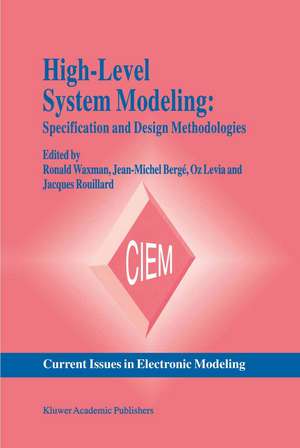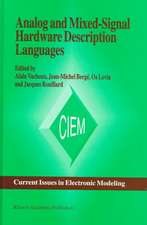High-Level System Modeling: Specification and Design Methodologies: Current Issues in Electronic Modeling, cartea 4
Editat de Ronald Waxman, Jean-Michel Bergé, Oz Levia, Jacques Rouillarden Limba Engleză Hardback – 31 ian 1996
- Specification modeling (linking object/data modeling, behavior modeling, and activity modeling).
- Operational specification modeling (modeling the way the system is supposed to operate - from a user's viewpoint).
- Linking non-functional parameters with specification models.
- Hybrid modeling (linking performance and functional elements).
- Application of high-level modeling to hardware/software approaches.
- Mathematical analysis techniques related to the modeling approaches.
- Reliability modeling.
- Applications of High Level Modeling.
- Reducing High Level Modeling to Practice.
| Toate formatele și edițiile | Preț | Express |
|---|---|---|
| Paperback (1) | 982.86 lei 6-8 săpt. | |
| Springer Us – 26 sep 2011 | 982.86 lei 6-8 săpt. | |
| Hardback (1) | 989.13 lei 6-8 săpt. | |
| Springer Us – 31 ian 1996 | 989.13 lei 6-8 săpt. |
Preț: 989.13 lei
Preț vechi: 1236.42 lei
-20% Nou
Puncte Express: 1484
Preț estimativ în valută:
189.29€ • 205.54$ • 159.01£
189.29€ • 205.54$ • 159.01£
Carte tipărită la comandă
Livrare economică 22 aprilie-06 mai
Preluare comenzi: 021 569.72.76
Specificații
ISBN-13: 9780792396604
ISBN-10: 079239660X
Pagini: 192
Ilustrații: XVI, 192 p.
Dimensiuni: 155 x 235 x 13 mm
Greutate: 0.48 kg
Ediția:1996
Editura: Springer Us
Colecția Springer
Seria Current Issues in Electronic Modeling
Locul publicării:New York, NY, United States
ISBN-10: 079239660X
Pagini: 192
Ilustrații: XVI, 192 p.
Dimensiuni: 155 x 235 x 13 mm
Greutate: 0.48 kg
Ediția:1996
Editura: Springer Us
Colecția Springer
Seria Current Issues in Electronic Modeling
Locul publicării:New York, NY, United States
Public țintă
ResearchCuprins
1. A System Specification Model and Method.- 1.1. Introduction.- 1.2. Overview of the Development Process.- 1.3. Objective, Nature and Quality of a Specification.- 1.4. Related Models and Methods.- 1.5. Essential Concepts for Specification.- 1.6. Model for Functional Specification.- 1.7. Object and Data Modeling.- 1.8. Activity Modeling.- 1.9. Behavioral Modeling.- 1.10. Specification of Performance Constraints.- 1.11. Technological Specifications.- 1.12. Specification Method.- 1.13. Expressing Functional Specifications.- 1.14. Specification Method applied to an Example.- 1.15. Specific Features of the Specification Model.- 1.16. Conclusions.- 2. Adept: A Unified Environment for end-to-end System Design.- 2.1. Introduction.- 2.2. The ADEPT Environment.- 2.3. Examples and Results.- 2.4. Conclusions.- 3. The Design Cube: A Model for VHDL Designflow Representation and Its Application.- 3.1. Introduction.- 3.2. Design and Modeling.- 3.3 The Y-Chart Model and VHDL.- 3.4 The Design Cube.- 3.5 Nodes in the Design Cube.- 3.6. Arcs in the Design Cube.- 3.7. An extension of the model.- 3.8. Applying the Design Cube to the Current Synthesis Technology.- 3.9. Conclusion and Future Work.- 4. A Novel Approach to Guiding Incremental Specification.- 4.1. Introduction.- 4.2. Problem Formulation.- 4.3. Solution.- 4.4. Example.- 4.5. Results.- 4.6. Elaborate Theory for the Identification of Refining Edges.- 4.7. Conclusion.- 5. An Expert Assistant for Hardware Systems Specification.- 5.1 Introduction.- 5.2 The Module Manager and the MODES Environment.- 5.3 The Module Manager and the CSIF Format.- 5.4 The Module Manager Architecture.- 5.5 The Knowledge Representation of the Module Manager.- 5.6 Conclusion.- 6. Integrating Non-Functional Aspects into Lotos.- 6.1. Introduction.- 6.2. Non-Functional Extensions.- 6.3. An Example.- 6.4. Properties of the Annotations.- 6.5. Conclusion.

































